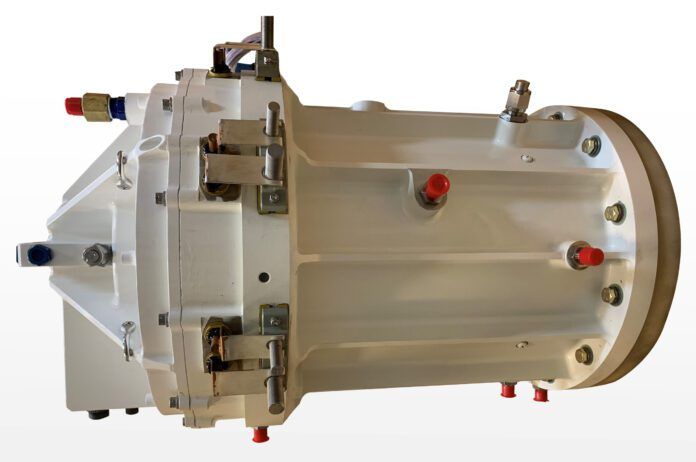Honeywell announced it has tested a one-megawatt generator designed specifically for hybrid electric aircraft. The generator weighs 280 pounds and has an efficiency rating of about 97 percent. “[The generator] delivers enough energy to power an entire neighborhood block,” Honeywell said in a news release. “Its compact size, low system weight and fuel savings translate into sustainable and operational benefits for hybrid-electric propulsion and other applications such as mobile charging stations, turbogenerator systems that can be flown in remote areas, and directed energy systems.”
The device was tested running continuously at 900 kilowatts during the test and Honeywell says its small size is a major technological advance in hybrid aircraft development. Its power output is calculated at 8 kW per kilogram (about 3.5 kW per pound) compared to about 0.65-1 kW per pound for existing generators. Honeywell’s generator is designed to work with the company’s gas turbine engines to create the most power-dense turbogenerators in the industry, including the ability to run on sustainable aviation fuel, and will “usher in an era of cleaner and less expensive air travel.”




































Two Hundred and Eighty POUNDS to generate only 900 Watts…. is a breakthrough?
I think not. Weighing only 49 lbs the Harbor Freight 1600 Watt continuous output generator will also run on auto fuel. Doh.
George, It’s a typo in the article. It’s 900kW rather than 900 W.
The unit generates 3.5kW per pound w/97% efficiency. The unit weights 280lbs.
280 x 3.5kW = 980, round down for efficient errors and were close to 900kW.
Thanks. I’ll fix the typo.
At least you listened to people, unlike the UN agency that burped up about loss of glacier area in the Himalayas without thinking about the sense of it – eco-activists had misplaced a decimal place.
🙄🙄🙄
Nothing is free. Carrying fuel enough for a jet engine to operate as well as it’s own weight, heat losses, power conversion losses, etc, etc ADDED to a plane powered by batteries? Less expensive and cleaner? Pull teh other one.
So the obvious solution is to mount this thing on a pylon with a big fan on it like an old-time wind generator. Right?? Right?? One step closer to the elusive Perpetual Motion Machine – time to line up that investors’ consortium.
OK, this is just the generator. It converts shaft horsepower into electricity. You still need 1000 hp to power it. Right?
More efficient generators are good, a supplier to Boeing achieved an advance on B767.
With modern analysis techniques it was so light that the traditional overload rating of several minutes was meaningless, as that was based on thermal inertia.
As for this Honeywell design, I presume it will take beefed up drive mechanism as the usual generators are much lower output. B737s were about 40KVA, options to about 170 for surveillance versions. Depends on airplane size of course, and system architecture – the more-electric B787 wants more. Though some architectures on twins use both direct drive and hydraulic drive to get redundancy.
The current go electric mania at least is producing some eye-opening advances in weight reduction for both motors and generators. Anyone who has worked with large backup generators can’t help be impressed by this 900 kW 280-pounder, even discounting the off-scene drive engine.
It’s a very nice piece of kit and very compact.
However, I think that trade off usually means small inneficient turbine blades and high noise levels (think J-57). As far as a generator, I doubt if your neighbors would stand for F-105 noise levels and pollution coming from your house during a power outage.
Okay, so we now have a 280 lb generator, that will have to be powered by a relatively heavy combustion engine, and then to run an electric motor to turn the prop. So now we have three engines and have to deal with the weight, and complexity of three separate systems so we can run an aircraft on electricity? The insanity seems to never end regarding electric propulsion and aircraft. The new generator may be a significant development but why associate it with aircraft systems?
Here’s what I think they’ve got in mind:
The aircraft in question requires 800 hp to maintain level flight at cruise altitude, BUT, that same 800 hp won’t get it off the ground or to altitude. To do that requires, say, 2000 hp. So, this generator, coupled with a 1000 hp turbine that runs at or near max power (internal combustion engines make best use of fuel consumed at near max power), will keep the aircraft at cruise speed /altitude. The extra power would be supplied by rechargeable batteries whose weight remains the same, reducing w/b complexities. The additional 200 hp would either be used to partially recharge the batteries in flight (needed if missed approach) or the generator engine power would be reduced to the needed 800, saving fuel accordingly.
At least, that’s how I’d do it and it is how I operate my plug-in hybrid car.
I see it similar to your take Chuck. I would add, very high altitude cruise with electric motor propulsion. This will allow cruise altitudes plus 40K feet. Then recapture some of that power on the long descents.
“Then recapture some of that power on the long descents.”
As in “regenerative braking”?
Thanks for the observation- I was wondering how this would be used operationally. Seems to be a good take on how this could be applied to conventional engines.
The problem will be when the labels say assembled in the USA with globally sourced parts. Anyone remember the Cessna 162…?